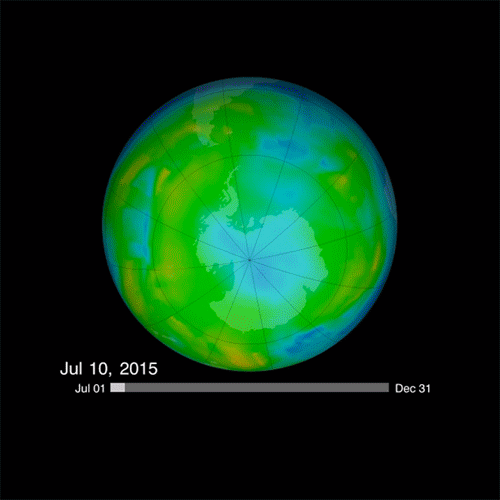Scientists observe first signs of healing in the Antarctic ozone layer
September ozone hole has shrunk by 4 million square kilometers since 2000
Jun 30, 2016 - by Staff
Jun 30, 2016 - by Staff
NCAR scientists Doug Kinnison and Michael Mills are co-authors on a new study published today in the journal Science. This is an excerpt from a news release by the Massachusetts Institute of Technology, a UCAR member institution, about the study.
 This animation shows the opening and closing of the Antarctic ozone hole (dark blue) in 2015. (Animation courtesy of NASA.)
This animation shows the opening and closing of the Antarctic ozone hole (dark blue) in 2015. (Animation courtesy of NASA.)
June 30, 2016 | Scientists at MIT and elsewhere have identified the “first fingerprints of healing” of the Antarctic ozone layer, published today in the journal Science.
The team found that the September ozone hole has shrunk by more than 4 million square kilometers — about half the area of the contiguous United States — since 2000, when ozone depletion was at its peak. The team also showed for the first time that this recovery has slowed somewhat at times, due to the effects of volcanic eruptions from year to year. Overall, however, the ozone hole appears to be on a healing path.
The authors used “fingerprints” of the ozone changes with season and altitude to attribute the ozone’s recovery to the continuing decline of atmospheric chlorine originating from chlorofluorocarbons (CFCs). These chemical compounds were once emitted by dry cleaning processes, old refrigerators, and aerosols such as hairspray. In 1987, virtually every country in the world signed on to the Montreal Protocol in a concerted effort to ban the use of CFCs and repair the ozone hole.
“We can now be confident that the things we’ve done have put the planet on a path to heal,” says lead author Susan Solomon, the Ellen Swallow Richards Professor of Atmospheric Chemistry and Climate Science at MIT. “Which is pretty good for us, isn’t it? Aren’t we amazing humans, that we did something that created a situation that we decided collectively, as a world, ‘Let’s get rid of these molecules’? We got rid of them, and now we’re seeing the planet respond.”
Solomon’s co-authors include Diane Ivy, research scientist in the Department of Earth, Atmospheric and Planetary Sciences, along with researchers at the National Center for Atmospheric Research in Boulder, Colorado, and the University of Leeds in the U.K.
Read the full release at MIT News.
Title: Emergence of Healing in the Antarctic Ozone Layer
Authors: Susan Solomon, Diane J. Ivy, Doug Kinnison, Michael J. Mills, Ryan R. Neely, and Anja Schmidt
Journal: Science, DOI: 10.1126/science.aae0061